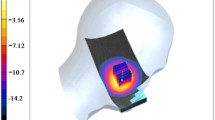Abstract
Most epidemiological studies investigating health effects of mobile telephone use have been criticised for poor quality of exposure assessment. Most used questionnaires which have limited precision to assess exposure. Clearly more relevant and direct methods of exposure assessment are needed. We describe the calibration of hardware modified phones (HMPs) for exposure assessment and dosimetry and verified their compliance with Australian and international standards. Specific energy absorption rate (SAR) values at various tilts and rotations and their combinations were obtained for the HMPs using a ‘DASY3’ SAR measuring system. Calibration involved placing HMPs on human head phantoms and taking measurements at 900 and 1800 MHz bands on right and left sides of the phantom. At 900MHz the maximum SAR obtained with HMPs at the touch position was 0.9W/kg and 0.4W/kg at 30 degrees tilt but at 1800MHz, SAR at the touch and 30 degrees tilts were 1.1W/kg and 1.3W/kg respectively. Whilst tilt and rotation each had an effect on SAR at constant frequency, no interaction was observed with rotation and frequency, however one was observed between tilt and frequency. At 1800 MHz mean SAR at 30 degrees tilt was 0.22W/kg higher (95% CI 0.15, 0.30) than at 0 degrees, whereas at 900 MHz mean SAR at 30 degrees tilt was 0.60W/kg lower (95% CI 0.52, 0.67) than at 0 degrees. Our results indicated that tilts influence SAR more than rotations. SAR values obtained at both 900/1800 MHz for the HMPs were well below ICNIRP limits for the general public. The phones were compliant with both international and Australian standards.
Similar content being viewed by others
References
Kheifets, L., Repacholi, M., Saunders, R. and van Deventer, E.The sensitivity of children to electromagnetic fields, Pediatrics,116(2): e303–13, 2005.
Ahlbom, A., Green, A., Kheifets, L., Savitz, D. and Swerdlow, A.Epidemiology of health effects of radiofrequency exposure, Environ Health Perspect, 112(17):1741–54, 2004.
Nokia. Nokia in the community. 2005 [cited 2008 URL accessed on 10 June 2008]; Available from: http://www.nokia.com/A4138170.
Funch, D.P., Rothman, K.J., Loughlin, J.E. and Dreyer, N.A.Utility of telephone company records for epidemiologic studies of cellular telephones, Epidemiology, 7(3):299–302, 1996.
Repacholi, M.H.Health risks from the use of mobile phones, Toxicol Lett, 120(1–3):323–31, 2001.
Diem, E., Schwarz, C., Adlkofer, F., Jahn, O. and Rudiger, H.Non-thermal DNA breakage by mobile-phone radiation (1800MHz) in human fibroblasts and in transformed GFSHR17 rat granulosa cells in vitro, Mutat Res, 583(2):178–83, 2005.
French, P.W., Penny, R., Laurence, J.A. and McKenzie, D.R.Mobile phones, heat shock proteins and cancer, Differentiation, 67(4–5):93–7, 2001.
Christensen, H.C., Schuz, J., Kosteljanetz, M., Poulsen, H.S., Boice, J.D., Jr., McLaughlin, J.K., et al.Cellular telephones and risk for brain tumors: a population-based, incident casecontrol study, Neurology, 64(7):1189–95, 2005.
Christensen, H.C., Schuz, J., Kosteljanetz, M., Poulsen, H.S., Thomsen, J. and Johansen, C.Cellular telephone use and risk of acoustic neuroma, Am J Epidemiol, 159(3): 277–83, 2004.
Hardell, L., Hallquist, A., Mild, K.H., Carlberg, M., Pahlson, A. and Lilja, A.Cellular and cordless telephones and the risk for brain tumours, Eur J Cancer Prev, 11(4):377–86, 2002.
Hardell, L., Mild, K.H., Carlberg, M. and Soderqvist, F.Tumour risk associated with use of cellular telephones or cordless desktop telephones, World J Surg Oncol, 4:74, 2006.
Hardell, L., Nasman, A., Pahlson, A., Hallquist, A. and Hansson, Mild K.Use of cellular telephones and the risk for brain tumours: A case-control study, Int J Oncol, 15(1):113–6, 1999.
Lonn, S., Ahlbom, A., Hall, P. and Feychting, M.Long-term mobile phone use and brain tumor risk, Am J Epidemiol, 161(6):523–35, 2005.
Rothman, K.J., Loughlin, J.E., Funch, D.P. and Dreyer, N.A.Overall mortality of cellular telephone customers, Epidemiology, 7(3): 303–5
D’Costa, H., Trueman, G., Tang, L., Abdel-rahman, U., Abdelrahman, W., Ong, K. and Cosic, I.Human brain wave activity during exposure to radiofrequency field emissions from mobile phones, Australas Phys Eng Sci Med, 26(4):162–7, 2003.
Hamblin, D.L. and Wood, A.W.Effects of mobile phone emissions on human brain activity and sleep variables, Int J Radiat Biol, 78(8):659–69, 2002.
Drossos, A., Santomaa, V. and Kuster, N.Dependence of electromagnetic energy absorption upon human head tissue composition in the frequency range of 300-3000 MHz, IEEE Transactions on Microwave Theory and Techniques, 48(11II): 1988–95, 2000.
Bit-Babik, G., Chou, C.K., Faraone, A., Gessner, A., Kanda, M. and Balzano, Q.Estimation of the SAR in the human head and body due to radiofrequency radiation exposure from handheld mobile phones with hands-free accessories, Radiation Research, 159(4): 550–7, 2003.
Collaboration. IEEE standard for safety levels with respect to human exposure to radio frequency electromagnetic fields, 3 kHz to 300 GHz. Copyright 1999, IEE: Inst. Electr. & Electron. Eng., New York, NY, USA; 1999. Report No.: IEEE Std C95.1, 1999 Edition.
Vrijheid, M., Armstrong, B.K., Bedard, D., Brown, J., Deltour, I., Iavarone, I., Krewski, D., Lagorio, S., Moore, S., Richardson, L., Giles, G.G., McBride, M., Parent, M., Siemiatycki, J. and Cardis, E.Recall bias in the assessment of exposure to mobile phones, J Expos Sci Environ Epidemiol. 2008.
Lahkola, A., Tokola, K. and Auvinen, A.Meta-analysis of mobile phone use and intracranial tumors, Scand J Work Environ Health, Jun;32(3):171–7, 2006.
Parslow, R.C., Hepworth, S.J. and McKinney, P.A.Recall of past use of mobile phone handsets, Radiat Prot Dosimetry, 106(3):233–40, 2003.
Hardell L, Carlberg M, Mild KH. Case-control study of the association between the use of cellular and cordless telephones and malignant brain tumors diagnosed during 2000–2003. Environ Res., 100(2):232–41, 2006
Inyang, I., Benke, G., McKenzie, R. and Abramson, M.Comparison of measuring instruments for radiofrequency radiation from mobile telephones in epidemiological studies: Implications for exposure assessment, Expos Sci Environ Epidemiol., 18(2): 134–41, 2008.
Hillert, L., Ahlbom, A., Neasham, D., Feychting, M., Jarup, L., Navin, R. and Elliot, P.Call-related factors influencing output power from mobile phones, J Expo Sci Environ Epidemiol., 16(6): 507–14, 2006.
Author information
Authors and Affiliations
Corresponding author
Rights and permissions
About this article
Cite this article
Inyang, I., Benke, G., McKenzie, R. et al. Use of hardware modified phones for exposure assessment in health studies in Australia: verification of compliance with standards. Australas. Phys. Eng. Sci. Med. 32, 62–67 (2009). https://doi.org/10.1007/BF03178630
Received:
Accepted:
Issue Date:
DOI: https://doi.org/10.1007/BF03178630




